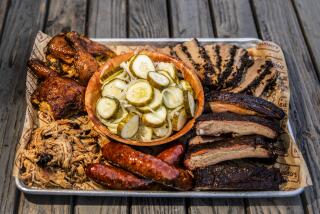Invite rosemary and anise to your next outdoor feast
- Share via
WOOD smoke -- hickory, apple, mesquite, name your favorite -- is a defining element of our barbecue heritage. And it’s much more than that. Wood was the foundation of all cuisine. It was the universal fuel of the human race, the one we cooked nearly everything on, right down to the 20th century.
And if that wood gave off smoke, all the better. Smoke is a natural preservative.
It adds flavor too, of course. Through all those millenniums of cooking on wood, people eventually learned to use particular varieties of wood for the attractive flavor of their smoke, so the knowledge of smoking woods is ancient. There were probably wood connoisseurs (and maybe even wood barbecue bores) in the days when grilled mammoth was the big party pleaser.
In short, wood has served us barbecuers long and well. We owe it.
But face facts: Wood smoke is not the only kind of smoke there is. A number of aromatic ingredients can be turned into flavoring smoke too.
Unlike wood, these herbs, spices and other aromatics don’t actually burn, and they contribute nothing to the heat of the barbecue. All that’s happening is that you’re driving out volatile oils and other aromatic elements. In the end, you don’t get gray ashes but blackened husks of the original ingredient.
As a smoke source, they have their limitations. Since their flavor isn’t distributed throughout a big, long-smoldering chunk, they don’t have staying power. Unless you’re willing to refill your barbecue’s chip container several times, aromatics are suitable only for short smoking. They really show best with meats that don’t need much cooking in the first place, such as fish (firm-fleshed varieties that won’t fall apart on the grill) or thin-sliced chicken breast, which you can find in supermarket meat departments these days.
The result, though delicious and fascinating, is not exactly barbecue. In fact, aromatic-smoked chicken or fish probably don’t work best as hot food right off the grill but as part of a cold buffet, at which you can savor their unique flavors at leisure, without worrying whether the food is getting cold.
Here’s how to do it. Fire up the barbecue to smoking temperature, around 200 or 225 degrees. Put an ounce of the herb or spice in the chip container (or the well-cleaned-out tin can you’re using instead) and set it on the hot coals, put in your chicken or fish and close the barbecue until the meat is done, around seven minutes, depending on the cut.
You don’t have to use premium herbs and spices for smoking. The inexpensive kind sold in little cellophane packets work fine.
The pungent spices and herbs work best. For instance:
* Rosemary: Gives a brusque, outdoorsy herbal scent, a whiff of the Mediterranean; good with both fish and chicken.
* Anise: Try this for a sweet, suave, sophisticated aroma. It’s quite nice with fish.
* Cinnamon: You may not smell much cinnamon aroma coming out of your barbecue’s chimney, but the scent will be there in the meat. Cinnamon-smoked salmon is particularly elegant.
* Cloves. The first five minutes will perfume your whole backyard, and then smoke production will drop off quickly. The overwhelming scent of cloves is willful, voluptuous and kind of simple-minded, like what’s-her-name on “The What’s-Her-Name Show.” A few cloves dropped in with seven or eight cinnamon sticks are probably more useful than an ounce of cloves by itself.
* Dried orange or tangerine peel: This is a traditional smoking ingredient in Chinese cooking and gives a warm, gentle, cheerful scent. A couple of cloves are welcome with it, suggesting the aroma of an old-fashioned pomander.


